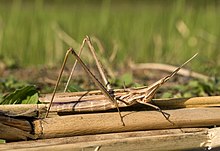| Acrida cinerea | |
|---|---|

| |
| Scientific classification | |
| Domain: | Eukaryota |
| Kingdom: | Animalia |
| Phylum: | Arthropoda |
| Class: | Insecta |
| Order: | Orthoptera |
| Suborder: | Caelifera |
| Family: | Acrididae |
| Subfamily: | Acridinae |
| Tribe: | Acridini |
| Genus: | Acrida |
| Species: | A. cinerea
|
| Binomial name | |
| Acrida cinerea (Thunberg, 1815)
| |
Acrida cinerea, sometimes called the Oriental longheaded grasshopper/locust[1] or the Chinese grasshopper[2] though this name is also applied to Oxya chinensis,[citation needed] is a member of the Acrididae family. Like other members of the genus Acrida, Acrida cinerea lacks stridulatory organs on its legs and so they do not make noise while moving.[2]
Acrida cinerea, like other Acrida species, is a pest of many agricultural crops. It is found throughout China, Japan, South East Asia and Indonesia.
Historically it has been used as a human food source,[2] and it has been investigated for its nutritional value for the poultry industry.[3]
Description
[edit]Acrida cinerea males are typically 40–50 mm (1.6–2.0 in) in length while females are 70–80 mm (2.8–3.1 in).[1] They are either green or brown in color with colorless wings.[2] A. cinerea has long legs which allow it to jump long distances.
References
[edit]- ^ a b Rowan Hooper. "Oriental long-headed locust". The Japan Times. Retrieved 2018-05-20.
- ^ a b c d Dana Campbell. "Chinese Grasshopper - Acrida cinerea - Details - Encyclopedia of Life". Encyclopedia of Life. Retrieved 2018-05-20.
- ^ Wang, Dun; Zhai, SW; Zhang, Chuan-Xi; Zhang, Qiang; Chen, Hui (2007). "Nutritional value of Chinese grasshopper Acrida cinera (Thumberg) for broilers". Animal Feed Science and Technology. 135: 66–74. doi:10.1016/j.anifeedsci.2006.05.013. Retrieved 2018-05-20.
External links
[edit] Media related to Acrida cinerea at Wikimedia Commons
Media related to Acrida cinerea at Wikimedia Commons
Well, that’s interesting to know that Psilotum nudum are known as whisk ferns. Psilotum nudum is the commoner species of the two. While the P. flaccidum is a rare species and is found in the tropical islands. Both the species are usually epiphytic in habit and grow upon tree ferns. These species may also be terrestrial and grow in humus or in the crevices of the rocks.
View the detailed Guide of Psilotum nudum: Detailed Study Of Psilotum Nudum (Whisk Fern), Classification, Anatomy, Reproduction